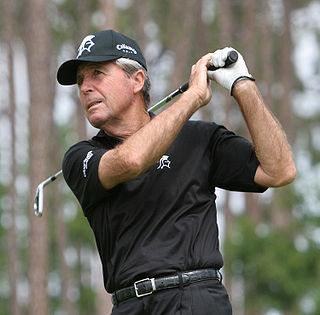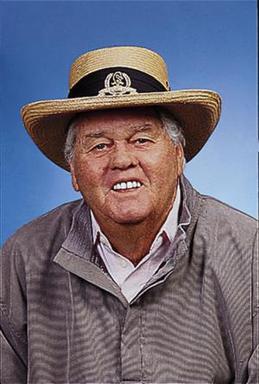
The Ryder Cup is a biennial men's golf competition between teams from Europe and the United States. The competition is contested every two years with the venue alternating between courses in the United States and Europe. The Ryder Cup is named after the English businessman Samuel Ryder who donated the trophy. The event is jointly administered by the PGA of America and Ryder Cup Europe, the latter a joint venture of the PGA European Tour (60%), the PGA of Great Britain and Ireland (20%), and the PGAs of Europe (20%).
The United States Open Championship, commonly known as the U.S. Open, is the annual open national championship of golf in the United States. It is the third of the four men's major golf championships, and is on the official schedule of both the PGA Tour and the European Tour. Since 1898 the competition has been 72 holes of stroke play, with the winner being the player with the lowest total number of strokes. It is staged by the United States Golf Association (USGA) in mid-June, scheduled so that, if there are no weather delays, the final round is played on the third Sunday. The U.S. Open is staged at a variety of courses, set up in such a way that scoring is very difficult, with a premium placed on accurate driving. As of 2023, the U.S. Open awards a $20 million purse, the largest of all four major championships.

Jack William Nicklaus, nicknamed "the Golden Bear", is a retired American professional golfer and golf course designer. He is widely considered to be either the greatest or one of the greatest golfers of all time. He won 117 professional tournaments in his career. Over a quarter-century, he won a record 18 major championships, three more than second-placed Tiger Woods. Nicklaus focused on the major championships—the Masters Tournament, U.S. Open, Open Championship and PGA Championship—and played a selective schedule of regular PGA Tour events. He competed in 164 major tournaments, more than any other player, and finished with 73 PGA Tour victories, third behind Sam Snead (82) and Woods (82).

Gary Jim Player DMS, OIG is a South African retired professional golfer who is widely considered to be one of the greatest golfers of all time. During his career, Player won nine major championships on the regular tour and nine major championships on the Champions Tour. At the age of 29, Player won the 1965 U.S. Open and became the only non-American to win all four majors in a career, known as the career Grand Slam. At the time, he was the youngest player to do this, though Jack Nicklaus (26) and Tiger Woods (24) subsequently broke this record. Player became only the third golfer in history to win the Career Grand Slam, following Ben Hogan and Gene Sarazen, and only Nicklaus and Woods have performed the feat since. He won over 150 professional tournaments on six continents over seven decades and was inducted into the World Golf Hall of Fame in 1974.

Thomas Sturges Watson is an American retired professional golfer on the PGA Tour Champions, formerly on the PGA Tour.

Muirfield Village is an “upscale” golf-oriented community in the central United States, located in Dublin, Ohio, a suburb north of Columbus.

The United States Amateur Championship, commonly known as the U.S. Amateur, is the leading annual golf tournament in the United States for amateur golfers. It is organized by the United States Golf Association and is currently held each August over a 7-day period.

Anthony Jacklin CBE is an English golfer. He was the most successful British player of his generation, winning two major championships, the 1969 Open Championship and the 1970 U.S. Open. He was also Ryder Cup captain from 1983 to 1989; Europe winning two and tying another of these four events.
The World Cup of Golf is a men's golf tournament contested by teams of two representing their country. Only one team is allowed from each country. The players are selected on the basis of the Official World Golf Ranking, although not all of the first choice players choose to compete. The equivalent event for women was the Women's World Cup of Golf, played from 2005 to 2008.
Brian William Barnes was a professional golfer. He won nine times on the European Tour between 1972 and 1981 and twice won the Senior British Open.
The following is a partial timeline of the history of golf.

Gay Robert Brewer Jr. was an American professional golfer who played on the PGA Tour and won the 1967 Masters Tournament.
Clive Anthony Clark is an English professional golfer and more recently a broadcaster and golf course architect.
The 17th Ryder Cup Matches were held October 20–22, 1967 at the Champions Golf Club in Houston, Texas. The United States team won the competition by a record score of 231⁄2 to 81⁄2 points. To date, the 15-point victory margin remains the largest at the Ryder Cup.
The Piccadilly Medal was a men's professional golf tournament on the British PGA tournament circuit that was played in 1962 and from 1964 to 1976. Since the circuit later evolved into the European Tour, the tournament is recognised as an official European Tour event from 1972. It was played in a variety of formats. From 1962 to 1967 it was a 72-hole stroke-play event, in 1968 it was a four-ball better-ball match play event, from 1969 to 1975 it was a knockout stroke-play event while in 1976 it reverted to the 72-hole stroke-play format. From 1964 to 1968 the event was played on the East course at Wentworth, just before the Piccadilly World Match Play Championship which was played on the West Course there. Carreras withdrew their golf sponsorship after the 1976 season.
The U.S. Women's Amateur is the leading golf tournament in the United States for female amateur golfers. It is played annually and is one of the 13 United States national golf championships organized by the United States Golf Association (USGA). Female amateurs from all nations are eligible to compete and there are no age restrictions. It was established in 1895, one month after the men's U.S. Amateur and U.S. Open. It is the third oldest USGA championship, over a half century older than the U.S. Women's Open, which was first played in 1946. Along with the British Ladies Amateur, the U.S. Women's Amateur is considered the highest honor in women's amateur golf.
The Minnesota State Junior Boys’ Golf Championship is an annual tournament conducted by the Minnesota Golf Association (MGA) to determine the state golf champion for boys less than 19 years of age. While the MGA traces the tournament back to 1924, the lineage to that first tournament is circuitous. Over the years, the state junior golf championship has encompassed four independently sponsored and differently named statewide tournaments with intervals during which two of the tournaments have overlapped.
Steve Oppermann is an American professional golfer. Oppermann had a sterling amateur career, being regarded as "one of the most talented amateurs in the West," culminating with victories at two "blue ribbon" events, the 1964 Western Amateur and California State Amateur Championship. Shortly after these victories he turned professional. He played on the PGA Tour for nine seasons and recorded two second-place finishes. However, he failed to win and did not record many other high results. In 1973 he quit tournament golf and has worked as a club professional in southeastern United States for the remainder of his career.










